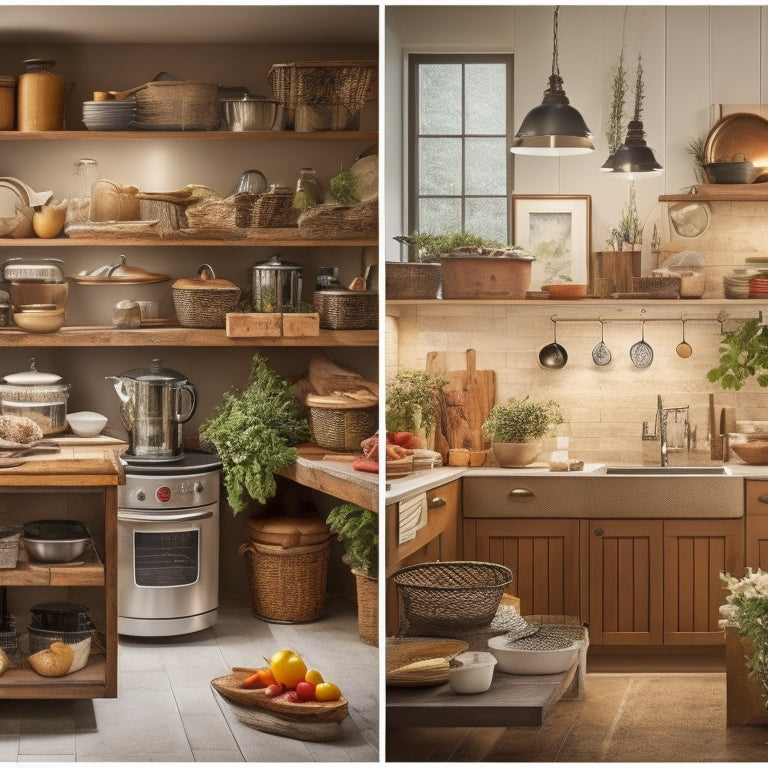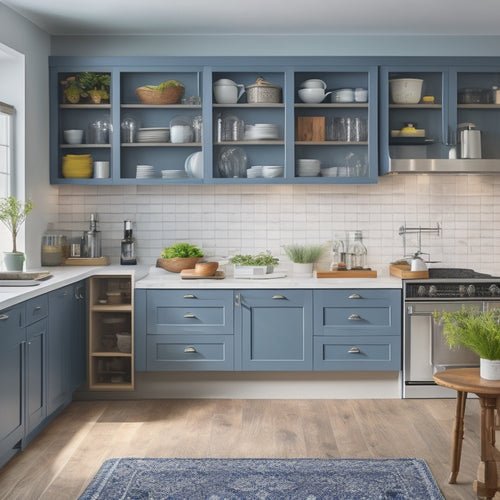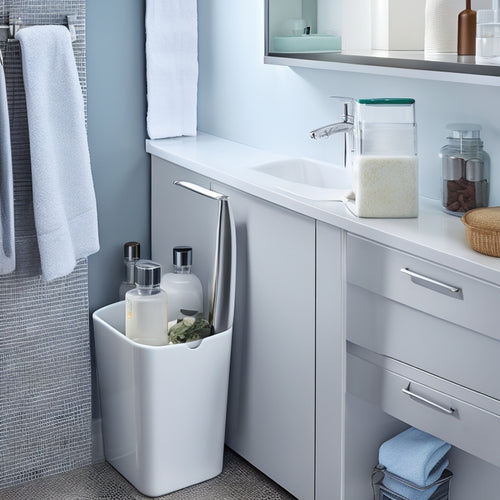
Decluttering Kitchen Cabinets: A Beginner's Step-by-Step Guide
Share
You're ready to declutter your kitchen cabinets! Start by gathering essential supplies like trash bags, a label maker, and a clear workspace. Clear your countertops by categorizing items, removing appliances, and wiping down surfaces. Next, remove everything from your cabinets, sort items into categories, and purify your collection by discarding broken or outdated items. Clean your cabinets thoroughly, then assign a home for each item, storing heavy ones below. Finally, establish habits to maintain your newly organized space. Now that you've got a solid foundation, explore more strategies to optimize your kitchen's potential.
Key Takeaways
• Start by clearing and cleaning countertops to create a workspace and visualize your ideal kitchen layout.
• Remove and sort items from cabinets into categories, such as baking supplies, cooking utensils, and dinnerware.
• Purge unwanted or broken items, including expired food, broken appliances, and chipped cookware.
• Assign homes for items, creating designated spots and zones for similar items, and storing heavy items below.
• Establish daily habits to maintain organized cabinets, including putting away dishes and utensils after each meal.
Prepare for Cabinet Decluttering
Embark on the task of decluttering your kitchen cabinets by gathering essential supplies like trash bags, a label maker, and a donation box. Having these tools ready will help you stay focused and motivated throughout the process.
Next, take a few minutes to reflect on your Kitchen Goals. What do you want to achieve with your newly decluttered cabinets? Do you want more storage space or a more organized cooking area? Defining your goals will help you stay committed to your Declutter Mindset.
Before immersing yourself in the cabinets, clear a workspace, like a table or countertop, where you can sort and categorize items. This will give you a clear view of what you're working with and make decision-making easier.
Consider enlisting the help of a friend or family member to make the task more enjoyable and to get a fresh perspective. With your supplies and workspace ready, you're now set to explore the world of decluttering your kitchen cabinets.
Clear Off Countertops First
To effectively declutter your kitchen cabinets, you'll need to start by clearing off your countertops. Take everything off, from appliances to decorations, and sort items into categories like 'keep,' 'donate,' and 'discard.'
Clear the Clutter
Take everything off your countertops, including appliances, utensils, and food items, to give yourself a clear view of what you're working with. This is the first step in decluttering your kitchen cabinets and gaining control over the kitchen chaos that's been driving you crazy. You can't organize what you can't see, so clear those countertops and take a deep breath.
As you survey the items you've removed, start to categorize them into groups. Ask yourself:
-
What can I throw away? Expired food, broken appliances, and worn-out utensils are all fair game for the trash or recycling bin.
-
What can I donate or sell? Gently used items that are still in good condition can find a new home with someone who needs them.
-
What can I store elsewhere? Items that you use infrequently, like special occasion dishes or seasonal decorations, can be stored in other areas of the house.
- What can I keep on the countertops? Only the items you use daily, like your coffee maker or toaster, should earn a spot on your countertops.
Free Up Space
Free Up Space
Clear off every inch of your countertops, leaving them completely bare, as this will give you the space you need to sort and categorize the items you've removed from your kitchen cabinets. This is essential, as cluttered countertops can make the decluttering process overwhelming. Start by removing everything, including appliances, utensils, and decorative items. Next, wipe down the countertops to remove any crumbs, spills, or stains.
Now, take a step back and visualize your ideal kitchen layout. Think about how you can optimize the layout to create efficient storage and workflow. Consider the items you use most frequently and how you can store them in easy-to-reach locations. This will help you create a functional and organized kitchen space.
Remove Everything From Cabinets
Now it's time to tackle the cabinets themselves.
You'll want to remove everything from the shelves and compartments, sorting items into categories as you go.
This will give you a clear view of what you have and help you decide what to keep, what to donate, and what to toss.
Purge the Shelves
Remove every item from your kitchen cabinets, clearing each shelf completely to get a good look at what you have and where it's been stored. This is your chance to start fresh and create a more organized kitchen.
As you take everything out, you'll be surprised at what you find - expired food, broken appliances, and mysterious containers.
Here are some things to keep in mind as you purge your shelves:
-
Dust and clean the shelves and cabinets before putting anything back.
-
Check expiration dates and toss any expired or spoiled food.
-
Discard broken appliances and consider replacing them with new ones.
- Set aside items for donation or sale, such as gently used dishes or cookbooks.
Empty the Compartments
You'll need to tackle the cabinets next, taking out everything from utensil holders to spice racks to get a clear view of what's inside. This is the most important step in achieving ideal cabinet organization. As you empty each compartment, categorize items into groups, such as baking supplies, cooking utensils, and dinnerware. This will help you visualize how you want to organize your cabinets.
| Category | Items to Remove | Action |
|---|---|---|
| Baking Supplies | Flour, sugar, baking powder | Set aside for reorganization |
| Cooking Utensils | Spatulas, whisks, wooden spoons | Clean and categorize by type |
| Dinnerware | Plates, bowls, cups | Inspect for chips or cracks, consider donating |
As you remove each item, inspect it for damage or expiration. Be honest with yourself – do you really need that broken spatula or expired spice? Set aside items that are no longer useful or functional. By emptying your cabinets, you're one step closer to achieving a compartmentalized living space that reflects your personal style and cooking habits.
Sort Items Into Categories
Take everything out of your kitchen cabinets and sort items into categories, such as baking supplies, cooking utensils, and food storage containers, to get a clear picture of what you have and where it should go. This step is essential in creating a functional and organized kitchen.
By grouping similar items together, you'll be able to see what you have, what you need, and what can be improved.
Here are some common category systems to keep in mind:
-
Baking supplies: flour, sugar, baking powder, etc.
-
Cooking utensils: pots, pans, ladles, spoons, etc.
-
Food storage containers: glass jars, plastic containers, ziplock bags, etc.
- Dinnerware: plates, bowls, cups, glasses, etc.
Purge Unwanted or Broken Items
With your categories in place, now's the time to scrutinize each group and get rid of anything that's broken, outdated, or no longer useful to you. Be ruthless – if you haven't used it in the past year, it's probably safe to let it go.
Start by identifying broken appliances, like that toaster that's been on the fritz for months or the blender with a cracked pitcher. These items aren't only taking up valuable space but also contributing to kitchen waste. Get rid of them to free up room for functional items and reduce the risk of electrical hazards.
Next, examine your cookware, dishes, and utensils. Are there any items that are chipped, cracked, or no longer serve a purpose? Consider donating gently used items to a local charity or thrift store. For items that are beyond repair, dispose of them responsibly to minimize kitchen waste.
Clean the Cabinets Thoroughly
Dust, dirt, and grime have likely accumulated on the shelves and walls of your kitchen cabinets, so grab a gentle cleaning product and a soft cloth to wipe down every inch of the interior surfaces. You want to remove any stubborn stains, crumbs, or spills that might've built up over time. This will give you a fresh start and prevent dirt from getting stuck under your newly organized items.
Here are some areas to focus on:
-
Dusty shelves: Use a microfiber cloth to remove dust and dirt from shelf surfaces. This will help prevent dust from spreading to your clean dishes and cookware.
-
Greasy walls: Use a gentle cleaning product and a soft-bristled brush to remove any tough grease stains on the walls of your cabinets.
-
Crevices and corners: Use a toothbrush or small-bristled brush to clean out any crumbs, dust, or debris that may have accumulated in tight spaces.
- Handles and knobs: Wipe down cabinet handles and knobs with a gentle cleaning product to remove any dirt, grime, or fingerprints.
Assign a Home for Each Item
Now that your kitchen cabinets are sparkling clean, organize your items by assigning a designated spot for each one, making it easy to find what you need when you need it. This step is important in maintaining your newly decluttered space.
Create Designated Zones within your cabinets by categorizing similar items together, such as baking supplies, cooking utensils, or dinnerware. This helps you visualize where each item belongs, reducing the likelihood of clutter buildup in the future.
Next, establish Personalized Stations within these zones. For example, designate a specific shelf for your favorite coffee mugs or a particular drawer for your most-used cooking utensils. This tailored approach ensures that everything has a home, and you'll develop a habit of putting things back in their assigned spot.
Store Heavy Items Below
You'll want to position your heaviest kitchen items, like large pots and appliances, on lower shelves or near the floor to create a stable and safe storage environment. This is essential for maintaining good weight distribution and preventing your cabinets from becoming top-heavy. By storing heavy items below, you'll reduce the risk of your cabinets tipping over or becoming unstable.
Here are some heavy items you should consider storing on bottom shelves:
-
Large pots and pans: These take up a lot of space and can be extremely heavy when filled with food.
-
Kitchen appliances: Items like slow cookers, stand mixers, and blenders are bulky and should be stored on lower shelves.
-
Canned goods: While not as heavy as appliances, canned goods can add up in weight and are often stored in large quantities.
- Cookbooks and binders: If you have a large collection of cookbooks or recipe binders, consider storing them on bottom shelves to keep them out of the way.
Maintain Your Organized Cabinets
By storing your heaviest items on lower shelves, you've taken the first step in creating a stable and organized kitchen; next, focus on implementing habits to maintain this organization and keep your cabinets clutter-free.
To do this, establish daily habits that promote tidiness. For instance, after each meal, put away dishes, utensils, and cookware in their designated spaces. This habit will prevent clutter from building up and make cleaning easier.
Additionally, schedule a seasonal refresh to reassess your cabinet's organization and make adjustments as needed. This can be as simple as wiping down shelves, reorganizing items, or donating unused kitchen gadgets. A seasonal refresh will help you stay on top of your kitchen's organization and make certain that your cabinets remain clutter-free.
Frequently Asked Questions
How Do I Deal With Expired or Stale Food in My Cabinets?
"You're not alone: 40% of food in the US goes uneaten! When tackling expired or stale food, you're fighting food waste. Start by purging outdated items, then organize your pantry with categories and 'first-in, first-out' shelving to maintain a fresh, waste-free kitchen."
What if I Have Limited Storage Space for My Kitchen Items?
You're short on storage space? No problem! You'll need efficient shelving and space savers to maximize your kitchen's potential. Consider installing adjustable shelves, baskets, or turntables to create a functional and organized space that feels like home.
Can I Repurpose Old Kitchen Items Instead of Throwing Them Away?
You can give old kitchen items a new life through creative upcycling, turning them into unique decor or functional pieces for your kitchen revamp, reducing waste and adding a personal touch to your space.
How Often Should I Declutter My Kitchen Cabinets to Maintain Organization?
You'll want to schedule a seasonal purge every 3-4 months to maintain organization, and make habit formation easier by setting aside 10-15 minutes weekly to tidy up and reassess your kitchen cabinet contents.
Are There Any Eco-Friendly Options for Disposing of Broken Kitchen Items?
Did you know that the average American generates about 4.4 pounds of trash per day? You're taking a step in the right direction by considering eco-friendly options! You can opt for Sustainable Recycling programs or make Green Donations to local charities, giving your broken kitchen items a second life.
Related Posts
-

Revamp Your Kitchen Storage With These Tips
A well-organized kitchen storage system is essential to a clutter-free and functional cooking space. To enhance your ...
-

Revamp Your Under-Sink Setup Like a Pro
To revamp your under-sink setup like a pro, start by evaluating your space and categorizing existing items, taking no...

